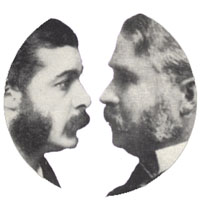
|
Gilbert
& Sullivan
|
|
a
selling exhibition of memorabilia
|
|
ARCHIVE:
Gilbert & Sullivan
|
 |
|
This archive page covers all the early London productions of the joint works of Gilbert & Sullivan. Many of the different programme cover styles are illustrated, and some variant cast information is given here, although there is much more information about the differing styles and casts on the D'Oyly Carte archive page. Most items on this page are not currently for sale. Early items for sale can be found here. |
| 1871 |
 |
Thespis The first Gilbert & Sullivan collaboration opened at the Gaiety Theatre on 26th December 1871. This early example of the programme was printed sometime before Jan 13th. The piece ran for 63 nights, not 64 as often stated, as there was a one-night break in the run. Most London theatre managements declined to present a fully costumed performance on Ash Wednesday, in order to show respect for the start of Lent. Hollingshead therefore replaced Thespis on 14th February 1872 with a "Miscellaneous Entertainment". (See example elsewhere in the archive.) |
| 1872 |
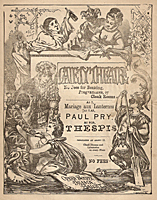 |
Thespis The companion piece, Dearer Than Life, was replaced by Ganymede & Galatea and Off the Line on 20th January, and by a revival of Paul Pry on 26th February, as seen here. The two pieces ran concurrently for only 9 or 10 performances as by 6th March (and possibly on 5th) Paul Pry was replaced by Uncle Dick's Darling. Thespis closed on 8th March 1872 and was given just one revival, at Mdlle. Clary's benefit on 28th April 1872. |
| 1875 |
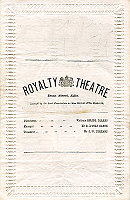 |
Trial by Jury Trial By Jury opened at the Royalty Theatre on 25th March 1875, playing, generally, as an afterpiece to Offenbach's La Perichole and a short piece titled A Good Night's Rest. The true initial run was rather short, as the theatre closed on June 12th, the company taking the production on tour. Although probably issued on 10th April 1875, it is possible that this programme was printed even earlier, as it does not mention the Associate, a role which is generally believed to have been named after 1st April. All the original cast members were in place at this exceptionally early date. Strictly, Carte was only the Manager, not the impressario, at this stage. |
 |
Trial by Jury This attractive programme dates from after May 5th 1875, when A Good Night's Rest was replaced by The Secret, which played with Trial by Jury and La Perichole until June 12th. The theatre then closed, and the production went on tour. Note Gilbert and Sullivan as cherubs on the cover. Carte, and scenes from Trial, appear inside. The original cast are all listed, except for C. Campbell as Foreman and C. Kelleher as Usher. |
 |
Trial by Jury Following their tour, the Trial By Jury company re-opened at the Royalty Theatre on 11th October 1875, again playing with La Perichole and a third piece, My Wife's Out, initially at least. By the date of this programme, 16th November, there had been some substantial cast changes and the piece was now described as "successful". The operetta was withdrawn on 18th December, having totalled an initial, if fractured, run of 131 performances. |
| 1876 |
 |
Trial by Jury On January 13th 1876 the production moved to the Opera Comique, where it was initially an afterpiece to Offenbach's Madame L'Archiduc. This Opera Comique programme, dated 14th February 1876, features the composer's brother Fred Sullivan in his original role as the Judge. Counsel, Usher and Foreman were all played by actors who had appeared at the Royalty. An inside page is shown, decorated with characters from Trial. |
 |
Trial by Jury During the 96 performance run of Trial by Jury at the Opera Comique it shared the bill with three different operettas. On this programme it was forepiece to Offenbach's Genevieve de Brabant, starring Emily Soldene, which dates it to between 18th March and April 1st 1876. Fred Sullivan was still The Judge and understudy "E. Cambell" (Charles ?) was The Defendant. Foreman was W.S. Penley, later famous in the title role of Charley's Aunt. |
| 1877 |
 |
Trial by Jury The first true revival of Trial By Jury was on March 3rd 1877 at the Strand Theatre, as afterpiece to Tom Taylor's Babes and Beetles and Charles Matthews' The Dowager. After the first two weeks George Leith took over the role of Judge from J.G. Taylor, but otherwise the cast remained the same for the whole of the run. This programme is dated for 27th March 1877. |
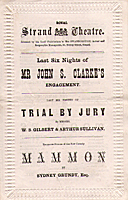 |
Trial by Jury This programme for the last week of performances of Trial By Jury at the Strand Theatre shows that it was, from Sat 12 May, afterpiece to Sidney Grundy's Mammon and the comic drama Toodles. The 73 performance run ended on 26th May 1877. |
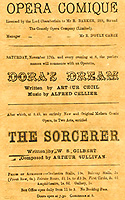 |
The Sorcerer - First programme The Sorcerer opened at the Opera Comique on 22nd November 1877, and it appears that no special programme was produced for opening night. However, this copy was issued during the first two weeks of the production, as it gives Act 2 as "Market Place in the Village", and has typographical errors consistent with the example reproduced by Reginald Allen, and which he considers likely to have been the first issued. This copy is dated for third night. |
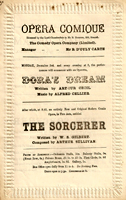 |
The Sorcerer Rosina Brandram was one of the stalwarts of the D'Oyly Carte Opera Company. From 1884 to 1903 she appeared in every Savoy piece which required a contralto, but even before this time she was in the chorus, and filled in for soloists in every G&S opera from The Sorcerer onwards. This extremely rare programme names Brandram as Lady Sangazure, filling in for Mrs Howard Paul, and is dated December 3rd 1877. |
| 1878 |
 |
The Sorcerer & Trial by Jury On 23rd March 1878 Trial by Jury was added as afterpiece to The Sorcerer at the Opera Comique, running alongside it for 56 performances. This programme, produced on 29th April 1878 by The Graphic, a firm that specialised in elaborately bordered playbills, used exactly the same artwork as would appear on the first Pinafore programme a few weeks later. The role of Notary is given here as "Counsel". |
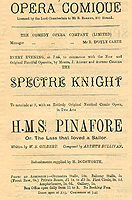 |
H.M.S. Pinafore - 3rd NIGHT This H.M.S. Pinafore programme is reliably dated in pencil for 28th May 1878, the third performance. This was the opening night of the first revival of the forepiece, Spectre Knight, and shows that Second Lady was played on this occasion by Miss Hervey, not Miss Muncey, as has been stated. |
 |
H.M.S. Pinafore This H.M.S. Pinafore programme is reliably dated in pencil for 7th August 1878, and is remarkable in that Ralph Rackstraw was played by a Mr Ferran, who is not listed in Rollins and Witts or any other source that we've seen, although this may be a mis-print for D'Arcy Ferris who played the role on occasion. Buttercup was Emily Cross, here appearing in the role much earlier than has been previously documented. |
| 1879 |
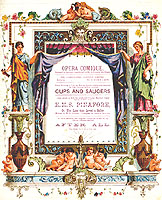 |
H.M.S. Pinafore Highly decorated programme featuring the original cast of Pinafore. The use of gold and full-colour litho would suggest that this was intended for use in only the very best seats, or at a special performance, although it is frustratingly undated. It must date from before the split between D'Oyly Carte and the Comedy Opera Company on 1st August 1879. |
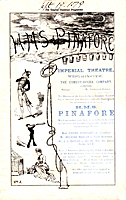 |
H.M.S. Pinafore (pirate production) On August 1st 1879 a rival production of Pinafore opened in London at the Imperial Theatre, part of the Royal Aquarium in Westminster, produced by the Comedy-Opera Company. This programme was printed in an edition of 1000 on 22nd August for use in that theatre, although it was dated by its original owner for Sept 19th, after the production had moved across town. If the date can be trusted this suggests that the piece was playing to rather poor houses, with less than a thousand programmes issued in over two weeks. The cover and inside pages have sketches of the production by the artist Pilotell. |
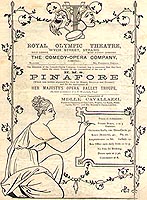 |
H.M.S. Pinafore (pirate production) On September 8th 1879 the pirate Pinafore moved to the Royal Olympic Theatre. On the cover, the production company still claimed that the piece was written "expressly for them by Messrs. Sullivan and Gilbert" ! |
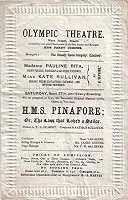 |
H.M.S. Pinafore (pirate production) The pirated Pinafore went through a staggering succession of cast members during its 91 performance run in two theatres, before closing on October 25th 1879. By 27th September the piece featured a pair of sopranos, Pauline Rita and Kate Sullivan, sharing the role of Josephine, playing alternate performances. Frederic Wood, as Ralph, is not listed in Rollins & Witts; and the programme also names Mr Dymott as Bob Beckett, the only actor from the original to take his chance with the producers of the rival production. |
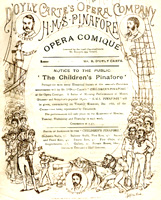 |
H.M.S. Pinafore Attractive H.M.S. Pinafore programme, with cover advert for The Children's Pinafore and dated in pencil for 13th December 1879. Many of the roles are played by cast members who would not be expected to appear at this date. Frank Thornton is Deadeye; Elinor Loveday is Josphine; Mr Montelli is Bobstay; Mr Ramsay is Beckett; and Haidee Crofton, Hebe. |
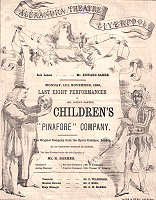 |
Children's Pinafore The Children's Pinafore opened at the Opera Comique on Dec 16th 1879, playing 78 matinees over the Christmas season. The production is represented here by a tour programme from August 1880 featuring all but two of the London cast members. |
| 1880 |
 |
H.M.S. Pinafore The cover of this similar programme states that it was produced for the "last performances" of Pinafore. It is dated by hand for Feb 9th 1880. After 571 performances the piece closed on Feb 20th. Again, there are a few unexpected cast members, most notably Fanny Holland as Josephine. The programme is decorated inside and out with scenes from the opera, and includes many plugs for the Children's Pinafore and an announcement that Pirates is due to open "at Easter". |
 |
The Pirates of Penzance The Pirates of Penzance was first seen in London at the Opera Comique on April 3rd 1880, where it ran for 363 performances, closing on April 2nd of the following year. This unusual programme printed on pale lilac paper, dates from before July 1880, as it features all the original London cast. |
 |
The Pirates of Penzance An unusual programme for The Pirates of Penzance at the Opera Comique. Although it clearly dates from before July 1880, Ellen Shirley plays Mabel. A note explains that this actress would "sustain the part during Miss Hood's indisposition". This would therefore appear to represent Ellen's debut in a solo G&S role, at least 6 months earlier than previously recorded. Otherwise, the cast is that which had been seen on the London opening night. |
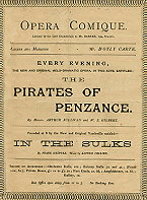 |
The Pirates of Penzance This strange programme was probably printed in September 1880, and certainly after July, when some of the cast returned from New York, having created their roles in the States. It is unusual in that Frederic is played by one "F. Seymour". Was this W.S. Seymour, the Opera Comique stage manager who deputised for George Power on odd occasions during the run ? Billie Barlow, as Isabel, is credited as "M. Barlow". It is possible that her real initial has been used here in error, as she had only recently adopted the name Billie. |
 |
The Pirates of Penzance This attractive programme, with artwork by Burnside, was used for a performance of Pirates featuring Durward Lely (making his D'Oyly Carte debut as Frederic) opposite Marion Hood as Mabel, thus placing it between Nov 1880 and January 1881. |
| 1881 |
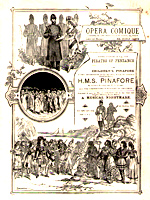 |
Children's Pinafore returns The Children's Pinafore had initially played at the Opera Comique during the run of Pinafore, but returned to the Opera Comique in a series of twenty eight matinees during the run of Pirates, between Dec 22nd 1880 and Jan 28th 1881. R. Presano, who had played Bob Beckett on tour, played Bill Bobstay. Also not mentioned in Rollins and Witts: A. Rivers was Bob Beckett and Fanny Carter was Hebe. |
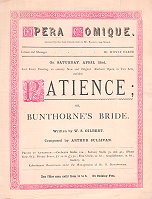 |
Patience - Opening Night Patience, or Bunthorne's Bride opened at the Opera Comique on April 23rd 1881. The first night programme has a distinctive red border on the cover. There was no curtain raiser on opening night. |
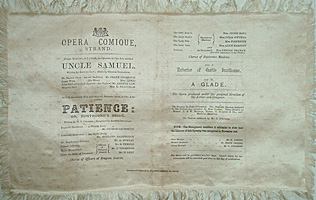 |
Patience SILK This 16"x 10" programme, printed on perfumed silk, names the complete original cast of Patience, before Richard Temple was replaced in September 1881, and includes the following notice: "The music will be published in a few days. Orders taken by the attendants will be executed post free on the day of publication". (The same notice has previously been noted on a programme dated 6th May.) The forepiece, Uncle Samuel, premiered on 3rd May 1881, and this souvenir most likely commemorated that opening, but no such confirmation is printed. Patience is played by "Lenora Braham" (sic). |
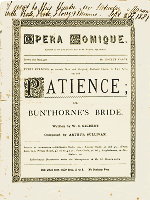 |
Patience Patience played for 170 performances before closing on October 8th, ready to reopen immediately at the new Savoy. This programme, dated September 24th 1881 shows no forepiece as it was for a matinee performance. The cast is as opening night, but with one important exception: Ellen Shirley in the title role. Although the programme states that this was her first appearance at this theatre, she had actually filled in for Marion Hood as Mabel on occasion in the previous January. |
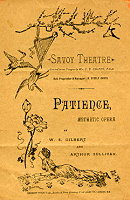 |
Patience Patience transferred to the new Savoy Theatre on 10th October 1881. Programmes are hard to date accurately, as we have to rely on dates written in by the original theatregoers. To add to the confusion, the programmes were printed in at least two designs and in many colour variations. This paper one, issued to those sitting in the cheaper seats, was originally bright orange paper but has since faded to beige.
|
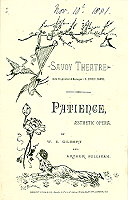 |
Patience The curtain raiser, Mock Turtles, was probably added to the bill around 15th November 1881, with Courtice Pounds creating the role of Mr. Wranglebury. This pale green cardboard programme, printed in iridescent green ink, is dated in pen "Nov 10th 1881" but this is probably a mistake - 1882 is much more likely as Arthur Law plays Wranglebury. Walter Browne appears as the Colonel; otherwise the Patience cast is as opening night. |
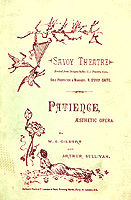 |
Patience This programme is similar, though decorated with scenes from the opera in iridescent red ink. Printed on card, it would have been given to those in more expensive seats. |
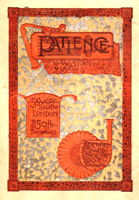 |
Patience - SOUVENIR Printed in New York, this elaborate souvenir programme was produced to mark a double occasion: the 250th London performance of Patience, and the 100th performance of the same opera in New York, on Dec 29th 1881. (Amazingly it appears that both anniversaries did indeed fall on about this date.) It includes cast lists for both performances and ten illustrations of scenes from the opera by J. E. Kelly. The cover design is based on four variants of harps and lyres, and the decorative border is a musical stave with the vocal line of "If you're anxious for to shine". |
| 1882 |
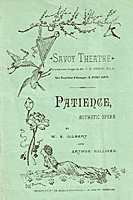 |
Patience This green (despite appearances) paper Patience programme is unusual in more than just its colour. Rosina Brandram occasionally filled in for Alice Barnett as Lady Jane, but here plays Lady Angela at a matinee performance. It is believed to date from either February or April 1882. |
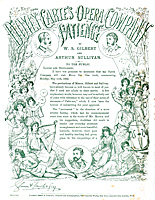 |
Patience on tour In May 1882 the Number 1 Patience company reached Hull. This elaborate four-sided flyer was distributed by the advance publicity team, and features G, S and Carte on the cover, with three pages of scenes from the operas by the artist "Orme". D'Oyly Carte explains that the piece is aims to lampoon the "new school" of aestheticism, with it's "unhealthy admiration for exhaustion, corruption and decay" rather than the movement in the Ruskin's day. |
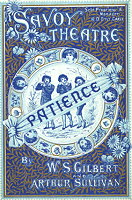 |
Patience One of the best designed decorative souvenir programmes, presumably produced to mark a special occasion, or possibly just for those sitting in boxes. Walter Browne played the Colonel. Printed in blue and gold, the cover depicts the military men in aesthetic guise in the centre of a blue and white china plate, while the inside has four vignettes from the opera and the portrait heads of Gilbert & Sullivan. The rear cover has an advert for the vocal arrangements. |
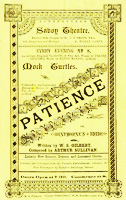 |
Patience This yellow paper programme uses completely different artwork. Walter Browne plays the Colonel - otherwise the cast remains as opening night. Patience ran for a further 408 performances at the Savoy, closing on November 22nd 1882 after a total run of 578 performances. |
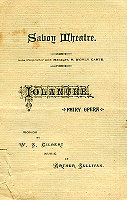 |
Iolanthe - Opening Night Iolanthe was the first piece to have its premiere at the Savoy Theatre, opening on 25th November 1882. This opening night programme states the date inside, and also notes that "on this occasion the opera will be Conducted by the Composer". This cheap-seats version is printed on an odd ribbed paper of pale green. |
 |
Iolanthe This programme, issued to those in better seats, is something of a classic, famously incorprating the Savoy's electric light bulbs into the decorative scheme. It dates from before February 1883, as Leila is played by Julia Gwynne, and Celia by May Fortescue. Rosina Brandram appears in the curtain raiser, "Mock Turtles" with Eric Lewis. |
| 1883 |
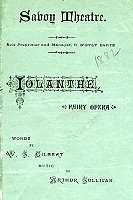 |
Iolanthe An undated pale green programme, with full first cast, there is no clue exactly when this may have been produced. The lack of curtain raiser suggests that it was for use at a matinee. |
 |
Iolanthe This blue programme, of the type issued to those in cheaper seats, dates from between February and August 1883, during which period Leila was played by Maud Cathcart. Although this matinee programme lists no curtain raiser, Iolanthe ran with Mock Turtles until 30th March 1883, and then A Private Wire until the end of its run. |
 |
Iolanthe Undated, but issued for a matinee of Iolanthe between February and August 1883, this attractive paper programme has six fairies flying around the Westminster clock. Phyllis and Strephon appear on the cover, and all the other major principals are pictured inside. |
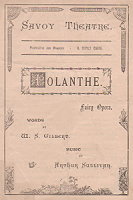 |
Iolanthe Also used at some point between February and August 1883, this unusual Iolanthe cheap-seats programme has a different design with a butterfly on the cover and, between the centre pages, a parrot in a cage. Clearly the printer, W. Aubert, used whatever motifs he had available and did not concern himself with the subject of the play! |
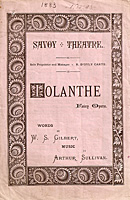 |
Iolanthe / A Private Wire Another variant cover, this pink programme has been dated by hand for 1st October 1883. Charles Manners still plays Willis, while Sybil Grey is Leila, Rose Hervey is Celia and Grace Arnold, Fleta. |
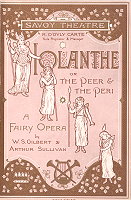 |
Iolanthe Beautiful programme printed in gold, pink and black, featuring the Queen with three fairies on the cover; Willis, Tolloller, Mountararat and Chancellor on the reverse; and Iolanthe, Strephon, Phillis and the Chancellor again within. This example can be firmly dated to October 1883 as the cast list has been amended with a stuck-on panel naming Charles Ryley, making his Savoy debut as Private Willis. The triple bill commenced at 8pm with A Private Wire, and after Iolanthe, at 10.50pm, Grossmith gave his drawing-room entertainment, The Drama on Crutches. |
 |
Iolanthe The cast changes in Iolanthe during its long run affected mainly the minor characters. This version of the regular programme, with a rather more conventional border, dates from after November 1883, when Warwick Gray was playing Private Willis. Iolanthe closed on Jan 1st 1884, after a run of 398 performances. |
| 1884 |
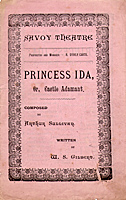 |
Princess Ida - Opening Night Princess Ida opened on 5th January 1884. This pink programme is dated in full, and unusually for a Savoy first night does not state that Sullivan would conduct. The composer was ill, and was not expected to appear, and the programme was printed accordingly, but, as anyone that has seen "Topsy Turvy" will remember, Sir Arthur insisted at the last moment that he would take his place in the pit. Miss Twyman is credited with creating the role of Ada, and the piece is described as being in a prologue and two acts. The back cover has an ad for Liberty fabrics. |
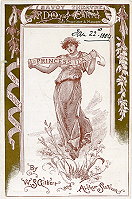 |
Princess Ida This exceptional programme was produced for those in the better seats, and has no advertisements of any kind. Dated 22nd Jan 1884, it describes the opera as being "in a prologue and two acts". Despite the early date, Ada was already being played by Lilian Carr. It is decorated inside with characters from the piece and is printed in maroon and gold. |
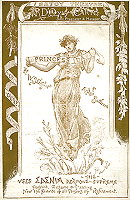 |
Princess Ida Superficially similar to the souvenir shown above, but note that the cover has been made into an advert, so that it now reads, "Princess Ida uses Edenia, the perfume supreme" ! It also has further adverts inside, and describes the opera as having three acts. It is printed in brown and gold. |
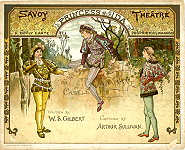 |
Princess Ida The regular Princess Ida souvenir programme has superb artwork by Alice Havers, with four colour, and four sepia, illustrations from the opera. The back pages use the characters as frames for advertisements. This example names Lilian Carr as Ada, but otherwise has the opening cast. |
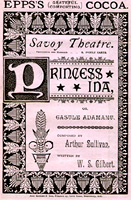 |
Princess Ida Dated for 7th March 1884, this Princess Ida programme shows all the opening night cast in place except Lilian Carr, who replaced Miss Twyman as Ada during the first month. A contemporary pencil notation suggests that Kate Chard, who usually played Psyche, took the lead role on this occasion. |
 |
Princess Ida An undated programme, this example has the same cast, but is printed on pale green paper. |
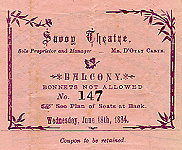 |
Princess Ida Rare ticket for Balcony seat at the Savoy Theatre for the Wednesday June 18th performance of Princess Ida in 1884. The reverse has a mini seating plan of the balcony, with all seats numbered, showing that seat 147 was in the back row. |
 |
The Sorcerer / Trial by Jury revival Opening Night D'Oyly Carte had no original opera to put into the Savoy following the relative failure of Princess Ida. The Sorcerer was therefore given a new act 2 opening, and paired with "Trial" for the opening night of the first DOC revival on October 11th 1884. As stated in this programme, Sullivan conducted the first performance. |
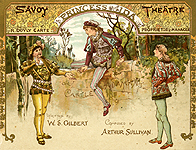 |
The Sorcerer / Trial by Jury D'Oyly Carte continued to use old artwork on his full-colour programmes for some time after each new opera opened. This Princess Ida cover was used for the first revivals even a month after they opened. |
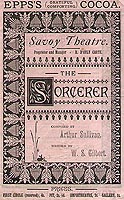 |
The Sorcerer / Trial by Jury Programme for the first revival of The Sorcerer and Trial By Jury, which ran together for 150 performances, until March 12th 1885. Durward Lely left the cast of Trial in mid-November, so this example must have been printed earlier. |
 |
Children's Pirates From Dec 26th 1884 until Feb 14th 1885, a company of children performed a series of matinees of The Pirates of Penzance at the Savoy. This four-sided foldout souvenir programme depicting the child actors on one side and full details of cast etc on the back was among the most elaborate and expensive ever produced by D'Oyly Carte. |
| 1885 |
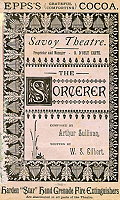 |
The Sorcerer / Trial by Jury There was only one cast change during the short (150 performance) run of Sorcerer/Trial, and this programme dates from February or March 1885, when Jessie Bond was replaced as Constance by Alice Davies. An indulgence slip, pasted into the programme, shows that Lyn Cadwaladr played Alexis, due to the indisposition of Durward Lely. The run ended on March 12th 1885. |
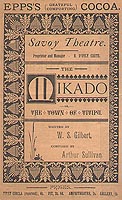 |
The Mikado The Mikado opened at the Savoy on March 14th 1885 and didn't close until Jan 19th 1887. This programme has all the original cast members in place, and must date from the first few weeks of the run, as it doesn't include the character Go-To, added in April 1885. |
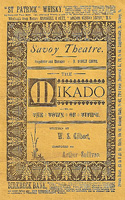 |
The Mikado Frustratingly undated, this Mikado programme lists all the opening cast members, with one important exception: Annie Cole plays Peep-Bo in place of Sybil Grey. It is known that Cole replaced Jessie Bond as Pitti-Sing in the Autumn of 1886, but it has not previously been recorded that she also played the smaller role at the Savoy. |
| 1886 |
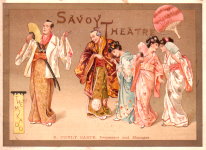 |
The Mikado Dated 23rd January 1886, this elaborate souvenir has six coloured pages depicting scenes from the previous operas. The cover design was reused and adapted over the following years. All the information normally found in a programme appears on page two, the rest being images and advertisements. |
 |
The
Mikado
A highly unusual programme naming Eric Lewis, Grossmith's understudy, as Ko-Ko and Ada Rose playing opposite him as Katisha. J. M. Gordon took Lewis' role in The Carp. Dated by hand for 11th February 1886. |
 |
The
Mikado
Dated by hand for 13th March 1886, this programme is perhaps most interesting for the indulgence slip was has been pasted inside, showing that Jessie Bond was indisposed, and that her part was taken by Annie Cole. Although Cole is known to have played Pitti-Sing from Sept to Nov 1886 this may have been the first occasion she stepped out from the chorus to play a major part. |
 |
The Mikado Frustratingly undated, this Mikado programme lists all the opening cast members, with one important exception: Annie Cole plays Peep-Bo in place of Sybil Grey. It has not previously been recorded that she played this small role at the Savoy. The casting of the companion piece, The Carp, suggests that the programme dates from August or September 1886. |
| 1887 |
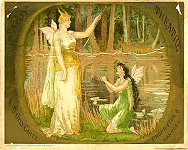 |
Ruddygore - Opening Night Ruddygore opened at the Savoy on January 22nd 1887. This opening night programme states the date inside, and also notes that "on this occasion the opera will be conducted by the composer". The souvenir has scenes from Iolanthe and Patience on the covers, and Pirates and The Sorcerer inside. |
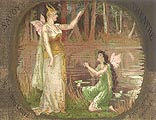 |
Ruddigore On, or around, 2nd February 1887, the spelling of the opera's title was changed, for reasons of decency. By the time this souvenir programme was printed, on 6th April, Josephine Findlay was playing Rose Maybud for a short period. All the other original major cast members were in place. |
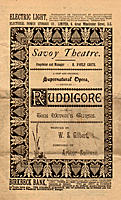 |
Ruddigore / The Carp Geraldine Ulmar replaced Leonora Braham as Rose Maybud in May 1887. In this programme, probably from August 1887, Aïda Jenoure is named in the the part, a change not noted by Rollins & Witts. Jenoure had created the role of Zora in America, but played the part (routinely) at the Savoy from May 1887 until the end of the run. |
 |
Ruddigore Quite late in the Ruddigore run the souvenir programme was changed to include scenes from the actual opera being performed. This programme, dated 1st Nov, has Geraldine Ulmar playing Rose and Aida Jenoure as Zorah. It would also appear that Rosina Brandram returned to her role of Dame Hannah before the opera closed, four days later, on November 5th 1887, after 288 performances. A rather less impressive run than The Mikado ! |
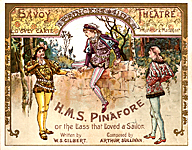 |
Pinafore - first revival - Opening Night On November 12th 1887, following the early close of Ruddigore, Richard D'Oyly Carte was forced, once again, to mount a revival at the Savoy. Pinafore was given a run of 120 performances, closing on 10th March 1888. This is the first night programme. |
 |
Pinafore Cheap-seats version of the programme for the first revival of Pinafore. During the run there were cast changes affecting the roles of Josephine and Hebe, but here Geraldine Ulmar and Jessie Bond, who had appeared on the opening night in 1887, are still in place. After the performance George Grossmith gave his drawing room sketch, "Homburg; or Haunted By the Mikado", as an afterpiece. |
| 1888 |
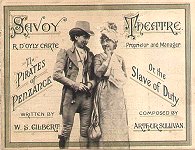 |
Pirates - first revival The Pirates of Penzance was given its first revival on March 17th 1888. It closed on 6th June, after just 80 performances - one of the shortest runs in the nineteenth century for a G&S opera. This example of the souvenir programme is dated 26th March 1888. The forepiece was Mrs. Jarramie's Genie. |
 |
The Mikado - first revival During the 116 performance run of the first Mikado revival there were a number of cast changes. This programme has Richard Temple in the title role, Geraldine Ulmar as Yum-Yum, Annie Cole as Pitti-Sing and Brandram, Grossmith and Barrington recreating their original parts. The curtain raiser was Mrs Jarramie's Genie. The revival opened at the Savoy on June 7th 1888 and ran until September 29th. |
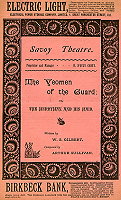 |
The Yeomen of the Guard The Yeomen of the Guard opened at the Savoy on October 3rd 1888. This first cast programme names Tom Redmond as 1st Citizen, a role he apparently only played during 1888. Mrs. Jarramie's Genie was the forepiece. Yeomen ran for 423 performances, closing on November 30th 1889. |
 |
The Yeomen of the Guard The first Yeomen of the Guard souvenir programme was this rather odd one, with a line drawing on the cover adapted from the 1885/6 Mikado souvenir. Inside are further line drawings of characters from other operas. This copy is dated 6th November 1888. |
| 1889 |
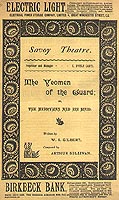 |
The
Yeomen of the Guard
Discreetly dated in pencil, this programme for The Yeomen of the Guard was most likely acquired at the Savoy on January 26th 1889. Note the colour variation. There appears to be no rhyme or reason to the different colours used - it is possible they represented different parts of the house, but I suspect it was more to do with what the printer had available. |
 |
Yeomen ticket Rare ticket for Stall seat at the Savoy Theatre for the Tuesday Jan 22nd performance of The Yeomen of the Guard in 1889. The reverse has a mini seating plan of the stalls, with all seats numbered, showing that seat 138 was in the eighth row. |
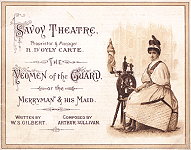 |
The Yeomen of the Guard Dated 29th March 1889, this style of souvenir, with Jessie Bond as Phoebe on the cover, was used in the middle of the run. Interestingly, Tom Redmond is named as 1st Citizen despite the late period. |
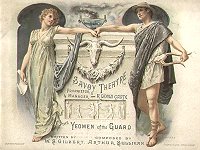 |
The
Yeomen of the Guard
Produced for those sitting in the better seats at the Savoy, the souvenir booklet includes coloured illustrations of scenes from The Yeomen of the Guard. It dates from September 2nd 1889, soon after John Wilkinson had replaced Grossmith as Point, and was printed in an edition of five hundred copies. This style of souvenir became the standard at the Savoy for the following five years or so. |
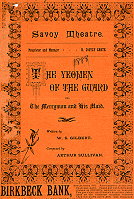 |
The
Yeomen of the Guard
A late programme for Yeomen, dated 23rd Sept 1889, printed on bright orange paper. Grossmith had been replaced as Jack Point by John Wilkinson in August 1889, and Mr Lees had taken the role of First Citizen at around the same time. Geraldine Ulmar's name has been crossed out by the original owner, and "Norah Phyllis" written in. If this were the fact it would have marked Norah's Savoy debut (she created the role of Giulia later in December 1889, and would cover for Ulmar again during the same month). |
| 1890 |
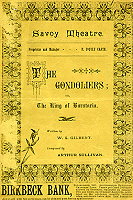 |
The
Gondoliers
From an edition of one thousand, printed on 20th March 1890, and apparently issued two days later, this programme shows that the majority of the cast who had opened the piece on December 7th 1889 were still playing their original parts. The exceptions are among the female characters, as here we have Annie Cole as Tessa, Jose Shalders as Vittoria, and Cissie Saumarez as Giulia. |
 |
The
Gondoliers
D'Oyly Carte had major problems with his Gianettas during the run of The Gondoliers. The part, created by Geraldine Ulmar, was played by a total of fifteen actresses during the 554 performance run (though interestingly these are not the same 15 sopranos listed in Rollins and Witts !). Here Gianetta is Esther Palliser. |
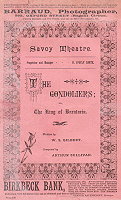 |
The
Gondoliers
Unusual not only because it is pink, this cheap-seats programme for The Gondoliers is dated 21st August 1890, and features George Temple (the original Samuel) as the Duke of Plaza Toro. |
| 1891 |
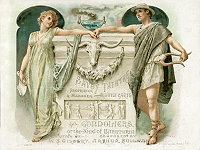 |
The
Gondoliers
On 5th Jan 1891 Nita Carritte took over the role of Gianetta, giving around 54 performances, until 27th February. This souvenir, printed on 9th Feb, has a number of other variant cast members: W.S. Laidlaw, Giuseppe; W.R. Shirley, Francesco; P. Burbank, Annibale; Rudolph Lewis, Ottavio; and Cissie Saumarez as Giulia. |
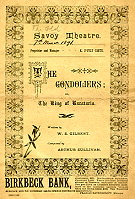 |
The
Gondoliers
By March 1891 Gianetta was being played by Carrie Donald and Giulia was Cissie Saumarez. Although the programme was issued on 7th March it had been printed four days earlier. The production closed on June 20th 1891 after 554 performances. |
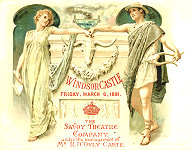 |
The
Gondoliers by
Royal command
This souvenir was produced for one of the most important events in D'Oyly Carte history, when The Gondoliers was presented in front of Queen Victoria at Windsor Castle on March 6th 1891. Very few can have been printed, and even fewer survive. Contrary to legend, the programme does name Gilbert as the author. |
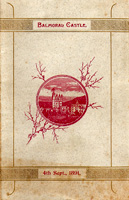 |
The
Mikado by Royal Command
Following the success of The Gondoliers at Windsor Castle in March, Queen Victoria commanded a further Royal Performance of G&S. D'Oyly Carte's "C" Company was playing Mikado, Yeomen and Gondoliers at Her Majesty's Theatre in Aberdeen when the cast made a special trip to the Queen's castle at Balmoral, where The Mikado was presented on Friday 4th September. This small cardboard programme was probably issued to members of the Royal Household. |
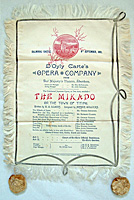 |
The
Mikado by Royal Command
This large souvenir, printed on cream silk, was probably presented only to the Royal Family and special guests. Interestingly, both the two examples known to have survived have extra loops of silver braiding on only the right and lower edges, and only this one has retained the two gold silk pom-poms which hang from the bottom edge. Both this and the card programme shown above feature the same view of Balmoral Castle, printed in red. |
| 1893 |
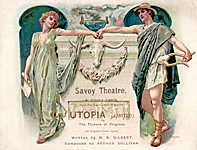 |
Utopia (Limited) - Opening Night Utopia (Limited), or The Flowers of Progress opened at the Savoy on 7th October 1893, running for 245 performances. This souvenir programme, issued to those in the better seats on the first night, notes that the composer would conduct. The brackets were removed from the title within a few weeks of the opening. |
 |
Utopia (Limited) - Opening Night There were two different programmes issued for the opening night of Utopia (Limited), this version issued to those in the cheaper seats. Faded to a pale green, it may possibly have been pink when issued. It is dated in full, and notes that "on this occasion the opera will be conducted by the composer". Both the first night programmes wrongly credit Florence Easton as Phylla. |
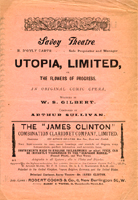 |
Utopia, Limited This programme is from 24th October 1893, and therefore includes all the original cast. Miss Howell-Hersee was originally employed simply to understudy Florence Easton in the tiny part of Phylla, but due to illness, she created the role. Miss Easton replaced her in November, after this programme was printed. |
 |
Utopia, Limited This green programme was printed later in the run, after Clarence Hunt had replaced Walter Passmore as Tarara. |
| 1895 |
 |
Utopia, Limited By 12th January 1894, when this programme was printed, Madeleine Galton was Melene and Florence Easton was Phylla. Utopia, Limited closed on June 9th 1894 after a run of 245 performances. |
 |
Mikado
2nd Revival - Opening
Night The second revival of The Mikado opened at the Savoy on 6th Nov 1895. The opening night programme is specifically dated, and includes the information that the composer would conduct. There was no curtain raiser before the first performance. The cover was printed in grayscale. |
 |
Mikado
/ After All The production featured Rutland Barrington, Jessie Bond and Rosina Brandram in their original characters. This sepia version of the cover is one of many different ones which were based on the 1885/6 souvenir. |
| 1896 |
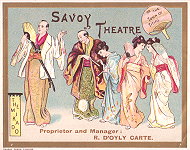 |
Mikado
/ After All
The same cover, but in colour, printed on 27th January 1896, presumably issued to those in better seats. The second Mikado revival closed after 127 performances, on March 4th 1896. |
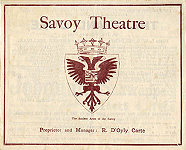 |
The
Grand Duke
The Grand Duke, Gilbert & Sullivan's final collaboration, opened on March 7th 1896. Different grades of programme were produced, this one, intended for the cheaper seats, has the Savoy crest and border printed in red. It was printed on 27th March 1896. |
| The
Mikado
During the run of The Grand Duke, between May 27th and July 4th, six matinee performances of The Mikado were given. |
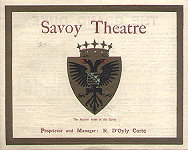 |
The
Grand Duke
The Grand Duke ran for just 123 performances, joined by the curtain raiser After All on 4th April, and closing on July 10th 1896. This programme, intended for the more expensive seats, has details printed in gold. |
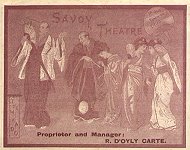 |
The
Mikado
Jessie Bond appeared on stage for the last time in the third revival of The Mikado, which opened at the Savoy on July 11th 1896, although she made guest appearances in galas after this date. One of 1000 printed on 27th July, this programme is dated by hand for the following night. The production also featured Rosina Brandram of the original cast, and closed after 226 performances, on February 17th 1897. |
| 1897 |
 |
Yeomen of the Guard First Revival - Opening Night This cardboard programme for the first performance of the first revival of Yeomen at the Savoy, which opened on 5th May 1897, clearly states that Sullivan conducted on opening night. Richard Temple, Rosina Brandram and H.Richards (Headsman) appeared in their original parts. |
 |
Yeomen of the Guard For just a few weeks during the first revival of Yeomen at the Savoy, in May 1897, Shadbolt was played by Tom Redmond. Other cast changes of note in this paper programme, intended for those in the cheaper seats, are Cory James as Leonard and Charles Childerstone as First Yeoman. The revival closed on November 20th 1897, after 186 performances, |
| 1898 |
 |
Gondoliers - first revival The Gondoliers was given its first revival at the Savoy on March 22nd 1898, with only Rosina Brandram of the original cast repeating her role. There was one cast change during the 62 performance run, but this programme, dated 19th May, shows Emmie Owen as Gianetta. In some programmes during this run Mildred Baker is listed as playing the mysterious character Carlotta! The revival closed on May 21st to make way for The Beauty Stone, which is advertised on the bottom inside edge. |
 |
Gondoliers - back again Following the failure of The Beauty Stone, The Gondoliers returned for a further 63 performances between July 18th and September 17th 1898. This first night programme for the revivification of the first Gondoliers revival shows that Sullivan did not conduct as this was not considered an "opening" as such. The cast was somewhat changed from the earlier segment of the run, with Robert Evett as Marco, Blanche Gaston-Murray as Tessa and Mildred Baker as Vittoria (Carlotta is not listed). |
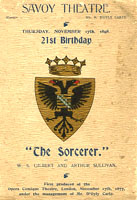 |
The Sorcerer 21st birthday Thursday November 17th 1898 marked the 21st anniversary of the opening night of The Sorcerer. To mark the occasion D'Oyly Carte produced one of his souvenir booklets, presumably available only to those present on the night. It includes photographs of all the leading characters in all the productions to date. |
 |
Sorcerer / Trial by Jury Regular programme for the 2nd Sorcerer revival, dated 5th December. The opera had opened on Sept 22nd 1898, and ran for 102 performances, in tandem with Trial by Jury, closing on New Year's Eve. At this point in the run Charles Childerstone was the Defendant with Henry Franckiss as the Associate, and Jones Hewson was Sir Marmaduke. |
| 1899 |
 |
Pinafore / Trial by Jury With only Richard Temple in his original role, HMS Pinafore was given its second revival (with Trial By Jury) on June 6th 1899. The production ran for 174 performances, closing on 25th November. This programme was printed on 11th October. |
| 1900 |
 |
Pirates Pirates was given its second revival at the Savoy, opening on June 30th 1900. Despite a short run of just 127 performances, there were a number of cast changes during the run. The work was preceded by The Outpost, adapted from the German piece by Korner. |
 |
Patience- Opening Night The first revival of Patience opened at the Savoy on November 7th 1900, and ran for 150 performances until April 20th 1901. There was no curtain raiser on opening night. |
 |
Patience Sir Arthur Sullivan, Richard D'Oyly Carte and Queen Victoria all died during the short run of this revival, and as a mark of respect the theatre was kept dark for a period to mark each of these events. This programme is dated for 28th December, and includes details of the Basil Hood / Francois Cellier curtain-raiser, Pretty Polly. |
| 1901 |
 |
Iolanthe first revival - Opening Night The first revival of Iolanthe opened at the Savoy on December 7th 1901, and ran for 113 performances until March 29th 1902. This programme is dated for the opening night, Dec 7th, although it was printed on the previous day. |
| 1902 |
 |
Iolanthe This "cheap seats" paper programme for the first Iolanthe revival was printed on 7th March, and includes details of The Willow Pattern, a curtain raiser by Basil Hood and Cecil Cook. |
| 1906/7 |
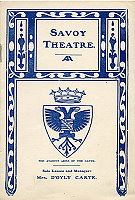 |
1st Repertory Season at Savoy Theatre December 1906 to August 1907: If title is a link, a prog is in stock. Alternate casts, colours and original prices, if any, are detailed lower on the same page.
|
| 1908/9 |
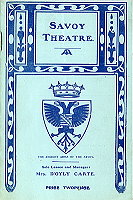 |
2nd Repertory Season at Savoy Theatre April 1908 to March 1909: If title is a link, a prog is in stock. Alternate casts, colours and original prices, if any, are detailed lower on the same page.
|
|
BIBLIOGRAPHY & ACKNOWLEDGEMENTS Thanks to those who have helped build this webpage. The Gilbert & Sullivan Archive pages have been invaluable, as have contributions from John McLean, George Low, David Eden, Stephen Turnbull and many others. To Alison Piano, a special thank-you for access to the fascinating research materials collected by her father, the G&S enthusiast, Philip Plumb. The Theatre Museum collection has also been an important resource - thanks to the staff there. Finally, thanks also to those who have offered to help fill image-gaps on these pages - however, all pictures are of items either currently or previously held in C20th stock. Information has mostly been gleaned from the following books: * Clarence, Reginald. The Stage Cyclopedia, Burt Franklin, 1909 (reprinted 1970) * Ganzl, Kurt. The British Musical Theatre, Vol 1, 1865-1914, Macmillan, 1986 * Wearing, J.P. The London Stage 1890-1899, Scarecrow, 1976 * Wearing, J.P. The London Stage 1900-1909, Scarecrow, 1981 * Wearing, J.P. The London Stage 1910-1919, Scarecrow, 1982 * Rollins, C. & Witts, R.J. The D'Oyly Carte Opera Company in Gilbert & Sullivan Operas, Michael Joseph, 1962
|